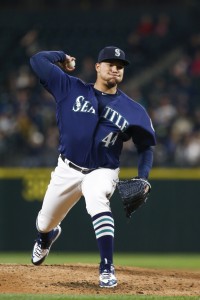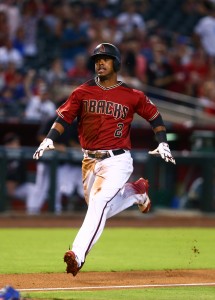Following their acquisition of Taijuan Walker from the Mariners last week, the Diamondbacks are expecting to receive increased interest in their stable of controllable starters, reports Ken Rosenthal of FOX Sports (via Twitter). As Rosenthal points out, each of Walker, Robbie Ray, Shelby Miller, Archie Bradley and Braden Shipley is between the ages of 24 and 26 and comes with at least three remaining years of clubs control. Patrick Corbin, meanwhile, is just 27 and has two years of control remaining.
[Related: Arizona Diamondbacks Depth Chart]
The D-backs figure to enter the 2017 season with a rotation consisting of Zack Greinke, Ray, Corbin, Walker and Miller, and it indeed seems not just conceivable but likely that their supply of intriguing young arms would draw interest from rival teams in an offseason where any type of quality starting pitching is in short supply.
Miller, who turned 26 in October, is perhaps the most obvious change-of-scenery candidate following a disastrous first season in Arizona that resulted in a 6.15 ERA across 101 Major League innings. After being acquired in the much-maligned trade that sent Dansby Swanson, Ender Inciarte and Aaron Blair to the Braves last winter, Miller pitched poorly enough in 2016 to merit a demotion to the minors. The small silver lining for the D-backs (and for interested teams) is that the demotion delayed Miller’s free agency by a year, so any team picking him up could still control him through arbitration for three more years. Miller is just a season removed from a 3.02 ERA with 7.5 K/9, 3.2 BB/9 and a 47.7 percent ground-ball rate in 2015 innings (with the Braves), but ownership has already reportedly intervened on one potential trade and may not want to green-light an offseason deal just a year after surrendering so much to acquire him.
Ray, 25, is the most appealing trade candidate of the bunch from my vantage point but could also be the most difficult to surrender. Though he’s already been traded twice in his career and is coming off a lackluster 4.90 ERA in 174 1/3 innings with Arizona this past season, he made several intriguing gains in 2016. Ray’s average fastball velocity trended up to 94.1 mph last year, and he posted a career-best 45.7 percent ground-ball rate. Most impressively, he averaged a hefty 11.3 K/9 that rated second in the Majors among qualified starters. Metrics like FIP, xFIP and SIERA all peg Ray for a mid-3.00s ERA, and he had some poor fortune in terms of balls in play (.352 BABIP) and home-run rate (15.5 HR/FB). Certainly, he needs some work — his control, for instance, could stand to improve — but the makings of a very good young starter are present.
Corbin once looked like a budding front-line starter for the Snakes but underwent Tommy John surgery that cost him all of the 2014 season. He showed promise with a 3.60 ERA in 85 innings upon his return in 2015, but the 2016 campaign was a dismal one. Though he totaled 155 2/3 innings, Corbin recorded just a 5.15 ERA as his strikeout, walk and home run rates all trended in the wrong direction, as did his velocity. If there’s a silver lining on his season, it’s that he not only stayed healthy but also posted a career-best 53.8 percent ground-ball rate.
Bradley and Shipley, as it stands, could be on the outside looking in when it comes to the rotation picture. Each is a 24-year-old former first-round pick (Bradley seventh overall in 2011, Shipley 15th in 2013) that has a bit of MLB experience but has yet to cement himself as a viable rotation option. Bradley struck out more than a batter per inning in 2016 (143 in 141 2/3 frames) but, like Ray, struggled with his control (4.1 BB/9). Like many other D-backs starters, Bradley’s BABIP (.338) was well above the league norm due at least in part to the team’s porous defense. With five years of team control remaining, though, Bradley should pique the interest of any team looking to add long-term rotation help despite the 5.18 ERA he carries through 177 1/3 big league innings.
Shipley, meanwhile, comes with the greatest amount of club control of any of the listed starters. He didn’t reach a full year of service in 2016, so he’d be controllable through at least the 2022 campaign. Shipley posted a 5.27 ERA across 70 innings last year, but his lack of missed bats proved problematic. That’s been a continuing problem for Shipley throughout his pro career, as his K/9 has been moving in the wrong direction as he’s ascended through the minors. Shipley logged a 3.70 ERA with 5.8 K/9, 1.7 BB/9 and a 46.6 percent grounder rate in a ridiculously hitter-friendly environment with Arizona’s Reno affiliate in the Triple-A Pacific Coast League, but he punched out just 5.5 hitters per nine in the Majors against 3.6 BB/9. He wasn’t able to get batters to chase outside the zone at even a league-average rate, and when he did, hitters made contact at a rate that was significantly above the mean rate for the league. Certainly, there’s appeal to a former first-rounder/top 100 prospect that reached the Majors as a 24-year-old, but Shipley likely could use some additional minor league refinement.
Of course, the D-backs needn’t shop any of their young arms around aggressively. All of the pitchers listed here have minor league options remaining and could be sent down to open the 2017 season depending on how things play out in Spring Training. Possessing sufficient, even potentially excessive depth in the rotation is never a bad thing for a team (and the D-backs aren’t exactly at a point of excess given the uncertainties up and down their staff), as injuries are bound to arise over the course of a season. And with the exception of Greinke, the financial motivation to move any of the team’s starters is virtually nonexistent. That each of these pitchers represents somewhat of a buy-low commodity might make it difficult for new GM Mike Hazen and his staff to extract fair value, but the parade of 5.00-ish ERAs delivered by this group shouldn’t suppress interest all that much on the trade market.


